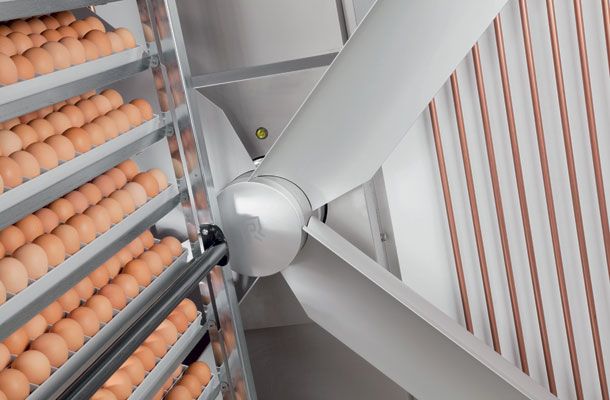Relevance of turning
Tags: Incubation | Whitepaper
, 27 August 2012

Broody hens provide optimum conditions for embryos developing in the eggs they are sitting on. The brood patch provides heat from one direction only, and the eggs at the side of the patch are cooler than those in the middle of the nest. However, because the broody hen regularly turns and moves the eggs in the nest, uniform egg temperature is achieved.
In commercial incubation, we try to mimic the natural conditions in the nest. From the point of view of uniform egg temperature turning of eggs seems to be of less importance in modern incubators. Are there other reasons for turning eggs?
As summarized by Deeming (2002), egg turning is essential to normal development for several reasons.
Egg turning
- Prevents adhesion of the embryo to the inner shell membrane.
- stimulates the rate of development of the area vasculosa (the membrane which grows around the yolk and is rich in blood vessels). The area vasculosa is important for sub-embryonic fluid formation, as well as for yolk uptake later in incubation.
- allows normal transfer of albumen proteins into the amniotic fluid, promoting optimum use of the albumen.
- supports the growth of the chorio-allantois (the blood vessels right under the shell) to maximise oxygen absorption.
- embryos in unturned eggs grow at a lower rate compared to embryos in eggs turned each hour over 90˚.
- facilitates movements of the embryo into the normal hatching position and reduces the incidence of malpositions in unhatched embryos.
Recently Elibol and Brake (2004) confirmed the finding of New (1957), that the most critical period for turning broiler hatching eggs is during the first week of incubation. Elibol and Brake observed differential effects due to an absence of turning between 0 to 2 days (primarily increased early mortality) versus 3 to 8 days (primarily increased late mortality).
The effect of not turning during the first half of incubation is only seen during the second half of incubation, but by then it is too late to take corrective actions. Turning failures during the second half of incubation will generally have less dramatic effects, although the growth rate of the embryo can be affected, depending on the moment and duration of the turning failure.
The angle through which the eggs are turned is important. Hatch of fertiles was significantly better in eggs turned over an angle of 45˚ either side of the short axis of the egg, as compared to turning of 30˚ and 15˚. Hatched chicks from eggs turned 45˚ weighed more and had less dry matter in the residual yolk. (Cutchin et al, 2007)
Advice
- Check the turning device before the start of each incubation cycle, as turning failures, depending on the moment of occurence, are detrimental to results.
- Check and maintain the turning device regularly, to prevent a breakdown during incubation.
- Make sure that turning does not produce shocks or jolts, as this adversely affects hatchability and chick quality.
- If necessary, check and adjust the turning angle: 45˚ is optimal.
- When eggs are transported to the hatchery on the same day as setting ensure they are kept 12 hours in horizontal position, even when this includes part of the incubation period. Eggs need some rest time to restore their ‘internal balance'.
- Turning is not absolutely necessary after 15 days of incubation. Especially in incubators with insufficient cooling capacity, it can be beneficial to leave the eggs in a horizontal position to facilitate increased air flow (cooling over the eggs). In some modern setters, there is also the option of turning to three different positions, e.g. 45 minutes each in right, horizontal and left position).
References
Deeming D.C. (2002). The role of egg turning during incubation. In: Practical aspects of commercial incubation in poultry. Ed. Deeming D.C. Ratite conference books. Pp 27 - 31.
Elibol and Brake (2004). Identification of critical periods for turning broiler hatching eggs during incubation British Poultry Science Oct; 45(5): 631 - 637.
Cutchin H.R. et al (2007). Embryonic development when eggs are turned different angles during incubation, International Poultry Scientific Forum - January 2007, Atlanta, Georgia.
Written by Gerd de Lange
Senior Poultry Specialist
I welcome your feedback on this article - and if you require any additional information, please don't hesitate to contact me.